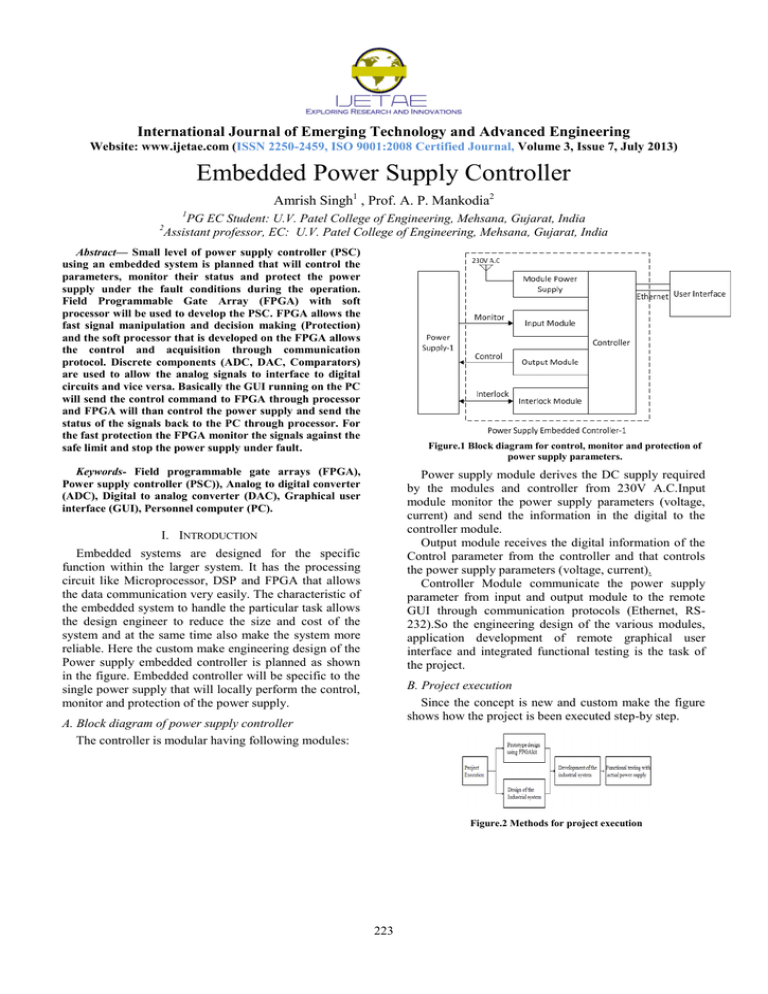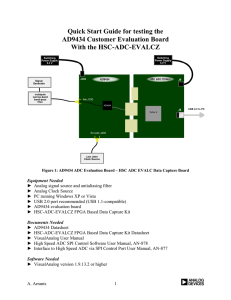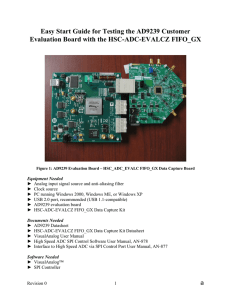
International Journal of Emerging Technology and Advanced Engineering
Website: www.ijetae.com (ISSN 2250-2459, ISO 9001:2008 Certified Journal, Volume 3, Issue 7, July 2013)
Embedded Power Supply Controller
Amrish Singh1 , Prof. A. P. Mankodia2
1
PG EC Student: U.V. Patel College of Engineering, Mehsana, Gujarat, India
Assistant professor, EC: U.V. Patel College of Engineering, Mehsana, Gujarat, India
2
Abstract— Small level of power supply controller (PSC)
using an embedded system is planned that will control the
parameters, monitor their status and protect the power
supply under the fault conditions during the operation.
Field Programmable Gate Array (FPGA) with soft
processor will be used to develop the PSC. FPGA allows the
fast signal manipulation and decision making (Protection)
and the soft processor that is developed on the FPGA allows
the control and acquisition through communication
protocol. Discrete components (ADC, DAC, Comparators)
are used to allow the analog signals to interface to digital
circuits and vice versa. Basically the GUI running on the PC
will send the control command to FPGA through processor
and FPGA will than control the power supply and send the
status of the signals back to the PC through processor. For
the fast protection the FPGA monitor the signals against the
safe limit and stop the power supply under fault.
Figure.1 Block diagram for control, monitor and protection of
power supply parameters.
Keywords- Field programmable gate arrays (FPGA),
Power supply controller (PSC)), Analog to digital converter
(ADC), Digital to analog converter (DAC), Graphical user
interface (GUI), Personnel computer (PC).
Power supply module derives the DC supply required
by the modules and controller from 230V A.C.Input
module monitor the power supply parameters (voltage,
current) and send the information in the digital to the
controller module.
Output module receives the digital information of the
Control parameter from the controller and that controls
the power supply parameters (voltage, current).
Controller Module communicate the power supply
parameter from input and output module to the remote
GUI through communication protocols (Ethernet, RS232).So the engineering design of the various modules,
application development of remote graphical user
interface and integrated functional testing is the task of
the project.
I. INTRODUCTION
Embedded systems are designed for the specific
function within the larger system. It has the processing
circuit like Microprocessor, DSP and FPGA that allows
the data communication very easily. The characteristic of
the embedded system to handle the particular task allows
the design engineer to reduce the size and cost of the
system and at the same time also make the system more
reliable. Here the custom make engineering design of the
Power supply embedded controller is planned as shown
in the figure. Embedded controller will be specific to the
single power supply that will locally perform the control,
monitor and protection of the power supply.
B. Project execution
Since the concept is new and custom make the figure
shows how the project is been executed step-by step.
A. Block diagram of power supply controller
The controller is modular having following modules:
Figure.2 Methods for project execution
223
International Journal of Emerging Technology and Advanced Engineering
Website: www.ijetae.com (ISSN 2250-2459, ISO 9001:2008 Certified Journal, Volume 3, Issue 7, July 2013)
The first step is to prove the concept with prototype
design. So the whole concept is designed using the
Spartan-3an FPGA starter kit [6] and it is tested with
dummy signal. Also application program for remote
operation is developed in Lab View software.
In parallel to prototype design the circuit design for
industrial system is carried out. The whole system is then
developed considering the industrial method and then
tested with actual power supply of ECH&CD system.
Figure.5 SPI Timing When Communicating with preamplifier[6]
II. PROTOTYPE DESIGN OF INPUT MODULE USING
SPARTAN 3 AN KIT
B. SPI Communication Interface for ADC (analog to
digital converter)
When the AD_CONV signal goes high, the ADC
simultaneously samples both analog channels. The results
of this conversion are not presented until the next time
AD_CONV is asserted, a latency of one sample. The
maximum sample rate is approximately 1.5MHz. The
ADC presents the digital representation of the sampled
analog values as a 14-bit, two’s complement binary
value.
Spartan-3an starter kit is used to perform prototype
design. As shown below the kit has 14-bit ADC (analog
to digital converter) that will act as input module for
power supply parameters monitoring.
Figure.3 input module on SPARTAN 3AN kit [6]
A. SPI(serial to peripheral interface) Communication
Interface for preamplifier
The gain for each amplifier is sent as an eight-bit
command word, consisting of two four-bit fields. The
most-significant bit, B3, is sent first.
Figure.6 SPI Timing When Communicating with
preamplifier [6]
C. Equations
The analog representation of the output is given by:
D [13:0]
(1)
=
8192XGAINX
(VIN
–
1.65)/1.25
D [13:0]: 14 bit representation of analog input.
GAIN: Gain of preamplifier.
1.65V: Reference voltage for each ADC.
III. PROTOTYPE DESIGN OF OUTPUT MODULE USING
SPARTAN 3AN KIT
Figure .4 SPI Control Interface for preamplifier[6]
The SPI bus communication with the amplifier is
shown in fig.4. Which starts on the falling edge of
AMP_CS and the data is actually read on SPI_MOSI
signal on the rising edge of the serial clock SPI_SCK
signal just after 30 ns, after the data is read then then
actual data is write on AMP_MOSI signal on the falling
edge of the SPI_SCK signal.
The DAC device is a Linear Technology LTC2624
quad DAC with 12-bit unsigned resolution. The four
outputs from the DAC shown in Figure 7
224
International Journal of Emerging Technology and Advanced Engineering
Website: www.ijetae.com (ISSN 2250-2459, ISO 9001:2008 Certified Journal, Volume 3, Issue 7, July 2013)
The LTC2624 DAC transmits its data on the
DAC_OUT signal on the falling edge of SPI_SCK. The
FPGA captures this data on the next rising SPI_SCK
edge. The High-going edge starts the actual digital-toanalog conversion process within the DAC.
C. Equations
VOUT=
(2)
VEREFERNCEX
D[11:0]/4096
VOUT=12 bit analog output voltage representation
VREFERNCE: Reference voltage available for each
DAC.
Figure.7 SPI Timing When Communicating with preamplifier [6]
A. SPI (serial to peripherel interface) for DAC(digital to
analog converter)
FPGA uses a Serial Peripheral Interface (SPI) to
communicate digital values to each of the four DAC
channels. A bus master the FPGA in this example drives
the bus clock signal (SPI_SCK) and transmits serial data
(SPI_MOSI) to the selected bus slave the DAC in this
example. At the same time, the bus slave provides serial
data (SPI_MISO) back to the bus master.
IV. EXPERIMENTAL RESULTS
Figure.10 Test bench result of preamplifier and I complete
clock cycle is 400ns
Figure.8 Digital-to-Analog Connection Schematics[6]
B. SPI Communication Details
After driving the DAC_CS slave select signal Low,
the FPGA transmits data on the SPI_MOSI signal, MSB
first.
Figure.11 result of preamplifier on CRO and the one clock cycle is
also 400ns
Figure.9 SPI Communication Details[6]
The LTC2624 captures input data (SPI_MOSI) on the
rising edge of SPI_SCK; the data must be valid for at
least 4 ns relative to the rising clock edge.
225
International Journal of Emerging Technology and Advanced Engineering
Website: www.ijetae.com (ISSN 2250-2459, ISO 9001:2008 Certified Journal, Volume 3, Issue 7, July 2013)
Figure.14 Test bench waveform of DAC
Figure.12 ADC SPI Control timing with timing between the 2 rising
edges of clock is 480 ns on Xilinx software
Figure.15 DAC SPI Control timing on CRO
Figure.13 ADC SPI Control timing on CRO
226
International Journal of Emerging Technology and Advanced Engineering
Website: www.ijetae.com (ISSN 2250-2459, ISO 9001:2008 Certified Journal, Volume 3, Issue 7, July 2013)
V. CONCLUSION
REFERENCES
Journal Paper References:
Since embedded power supply controller is used as a
localized solution for individual power supply so it
provide the customized approach to control number of
power supply by designing specific controller as per the
power supplies. Embedded power supply controller also
reduces number of cables and connection required for
controlling the power supplies and also reduction in size
and cost of the system by improving the reliability and
performance. Hence we came to conclude that as an
option by following the above features merits and desired
results from the embedded power supply controller which
are same by using COTS(commercially available off the
shelf system) systems using PLC and PXI we can use
embedded power supply controller.
[1]
[2]
Amine Mezghani and Josef A. Nossek. “How to
choose the
ADC resolution for short range low power communication,
publication year 2010 by IEEE conference publication
IEEE, IEEE Standard VHDL Language Reference Manual (IEEE
Srd 1076-2001), Institute of Electrical and Electronics Engineers,
2001.
Book References:
[3]
[4]
[5]
J. Bhasker, A VHDL Primer, 3rd Edition, Pearson Prentice Hall,
New Delhi, 2006
P. J. Ashen den, The Designer’s Guide to VHDL, 2nd ed.,
Morgan Kaufmann, 2001
J. 0. Hamblen et al., Rapid Prototyping of Digital Systems:
Quartus@ II Edition, Springer, 2005.
Datasheet Reference
[6]
Spartan-3A/3AN FPGA Starter Kit Board User Guide/UG334
(v1.1) June 19, 2008
[7] Complete, Quad, 12-/14-/16-Bit, Serial Input, nipolar/Bipolar
Voltage Output DACs 5754R
[8] Ultra low Distortion, Ultra low Noise Op Amp 2.5 V/3.0 V High
Precision Reference AD780 AR
[9] 5V to 3.3 V voltage converter IC 3303.
[10] 2-Channel, Software-Selectable, True Bipolar Input,1 MSPS, 12Bit Plus Sign ADC 7322
Acknowledgement
I would like to thank all who have been instrumental
in my growth as engineering professional.My great
obligations remain towards Prof. Anand.P.Mankodia, for
being a constant source of inspiration, and acting as a
guide, helping me throughout my stint in the college,
participating actively in the report development process,
providing me with all the facilities, and who has done
much beyond expectations to bring out the best in me.
227





